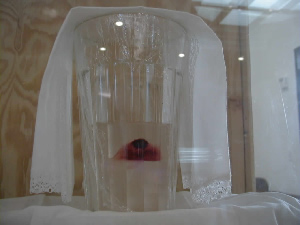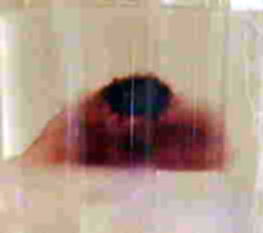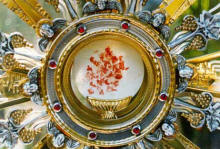
Spirit Daily
__________________________________________
Claim That Host Turned To Flesh And Blood In Dallas
Four stories

www.spiritdaily.com
First Story
"You may have already heard but if not, there appears to be an incredible Eucharistic Miracle that occurred March 19th (feast of St. Joseph) in the church of St. James in Dallas, Texas," writes Candy Grove, board member of the Queen of Peace Center in Dallas. "The pastor there is Msgr. Mario Magbanua. It's in a very poor section of Dallas across the street from the Sisters of Charity Convent.
"My family and I just returned from the church. The Bishop has been out of town and unavailable. The custodian from the church told us the story in broken English. It seems that about thirty days ago during Communion, a young boy received the host. For some reason he did not swallow it, but spit it out on the floor of the bathroom. The priest followed him and picked the precious Sacred Host up from the floor. The priest placed it in water to dissolve it. After thirty days the host had still not dissolved, so he added more water and the Sacred Host moved from the side of the container to the middle and immediately became bloody flesh. It is on display, but not many people know about it yet. While we were there there were a few nuns and a priest who came to venerate the 'Eucharistic Miracle.'"
A similar claim was claim in 1996 in Barbeau, Michigan, where there were spectacular photos of a Host that seemed to have turned into actual flesh and blood. During Mass at the Church of the Holy Family on February 4, it seems an inexperienced Eucharistic minister dropped a Host onto a paten. "Believing that this Host had to be placed in an ablution cup, the minister informed the priest of this despite the fact that the Host hadn't touched either the ground or a communicant," notes one website. "The Host remained in the cup for a week because inclement weather prevented any weekday Masses. The following Sunday, February 11th, a dime-sized red coloration was seen on the surface of the Host. The Host, which had been in water to help dissolve it, was engorged with water but otherwise retained its shape. The local bishop, who was advised of these developments via telephone, suggested to the parish priest, Father Mark A. McQuesten, that the coloration was probably due to a fungus growing on the Host and that it should be disposed of in the approved manner."
Stay tuned...
03/21/06

Second Story
Diocese of Dallas![]()
Communion "host" in Dallas church grew fungi, bacteria naturally
|
|
By MARTY PERRY
Texas Catholic Online @http://www.texascatholic.com
DALLAS. A “host” kept in a jar of water for four
weeks grew fungus and bacterial colonies in a natural process, a laboratory
report concluded about an incident in a local parish church that created public
speculation.
A March 23 letter from Dallas Bishop Charles Grahmann to the pastor of St. James
Parish relayed that what some were calling a ‘miracle’ of a host “contains
nothing of a supernatural nature.”
The letter to Msgr. Mario Magbanua states: “At my request the object you
submitted to me, around which there was heightened publicity, was presented to
Dr. Marcy Brown Marsden, chairman and associate professor of biology, University
of Dallas, and Dr. Frank Doe of the same department, for tentative
identification and characterization of the object.”
The bishop said that after analysis was done he was provided with their
conclusion.
They told the bishop: “We conclude that the object is a combination of fungal
mycelia and bacterial colonies that have been incubated within the aquatic
environment of the glass during the four-week period in which it was stored in
the open air.”
The bishop further wrote: ““From this conclusion the phenomenon was of the
natural order and contains nothing of a supernatural nature. Thus, you need to
remove yourself from any further activity surrounding this matter and its
exaggerated claims.”
The incident began about a month ago when a young boy received the Eucharist at
Mass and then became sick in the restroom. Ushers who checked on him found the
intact host in the bin.
The ushers reportedly summoned Msgr. Magbanua, who came to retrieve the host. He
put the host in water to dissolve, where it remained unseen until March 19. Its
appearance had changed, viewers said.
Within hours people were coming to the church to see the host, which is located
in a low-income area and has approximately 2,000 registered parishioners.
Fueled by telephone and e-mail stories saying a miracle had occurred, as well as
media reports, curious scores of the faithful hoping to see something
extraordinary began to show up.
Among those was Shirley Vilfordi, a member of St. Rita Parish in Dallas. She was
among those who suggested people should not be too quick to rush to conclusions,
and thanked those who took quick action to discover the truth.
“We praise God for our beloved church who wants to investigate these things
thoroughly rather than falsely mislead the faithful,” Vilfordi said as the
investigation was ongoing.
There have been other cases in past years when a host received fungal and/or
bacteria contamination when it was not properly consumed and/or disposed.
Church officials said the matter is now closed and called on faithful to end any
further speculation.
3/25/06
When It Comes To Eucharistic 'Miracles,' Would God Speak Even Through Fungus?
Third Story
 The
recent claim of a Eucharistic miracle at a church in Dallas has highlighted
another phenomenon that has been asserted with increased frequency during recent
times: that of "bleeding" Hosts, or at least Communion wafers that exhibit red
coloration.
The
recent claim of a Eucharistic miracle at a church in Dallas has highlighted
another phenomenon that has been asserted with increased frequency during recent
times: that of "bleeding" Hosts, or at least Communion wafers that exhibit red
coloration.
In recent years, such manifestations have been reported in Betania, Venezuela; in Barbeau, Michigan (where a priest ordered to dispose of such a Host consumed it instead, and claimed it was actual flesh); in Piqua, Ohio, where Communion in water exhibited a large spot of red; in Rome, Italy; in Marlboro, New Jersey; near Salt Lake City, Utah (there, it was a chalice with a red droplet); in Worcester, Massachusetts; in Naju, Korea (to a seer who also had an alleged experience after receiving from John Paul II); and in California -- to name just those that readily come to mind.
Such claims go back at least to the eighth century, when a Communion Host in Lanciano, Italy, turned to flesh and blood -- a phenomenon that remains preserved in a church there, and that tests have shown to be the same AB blood type as in the Turin Shroud.
In the recent Dallas case, a Host had been disposed by a sick child in the restroom of a local church and then placed in water, where it developed a striking bright redness that some took to be blood and that proceeded to cause a brief sensation [below, left].
The
operative word was "brief" because just days after the first reports in March,
an analysis conducted by Dr. Marcy Brown Marsden, chairman and associate
professor of biology, University of Dallas, and Dr. Frank Doe of the same
department, at the request of Bishop Charles Grahmann, determined that the red
was caused by fungal and bacterial colonies.
“From this conclusion the
phenomenon was of the natural order and contains nothing of a supernatural
nature," noted Bishop Grahmann in a March 23 letter to the pastor of the parish,
St. James. "Thus, you need to remove yourself from any further activity
surrounding this matter and its exaggerated claims."
The case hearkened not only to the Barbeau event, where the bishop there too
said that it was fungus, but to a highly similar event in Peterborough, Ontario,
where a priest named Father Heffernan who has been active in alleged Marian
phenomena discovered on Christmas Eve of 1993 that a glass of water in which
three Hosts had been placed to dissolve them (after elderly to whom he had been
administering them were unable to swallow them, over the course of several
months) had developed a strange red spot below the water line.
When the "spot" was examined by a chemistry professor at Trent University, the conclusion was similar: that the red was caused by a fungus, although the scientist was baffled, according to the priest, as to the red color. Witnesses asserted that in some slides the spot looked like a heart and that they saw an "unmistakable" white cross and other images.
The Canadian priest then flew to Florida, where he brought the specimen for examination by a biophysicist and entomologist named Dr. Phil Callahan, a devout Catholic who said that "the red stain did indeed turn out to be a fungus. Under the microscope a red mycelium could be seen spreading out in radial fashion from the center of the organism. A mycelium is a fine mass of interwoven threads that form the vegetative portion of the fungus."
Continued the scientist (who recites the Rosary): "It is well known that the threads of fungus contain many substances of various kinds, such as crystals of calcium oxalate, resins, protein granules, and most important of all, in the case of this specimen, different colored oil drops, e.g. green, yellow, or red. The latter," he concluded, "accounts for the red color of the Eucharistic mold."
Still, Dr. Callahan remained perplexed over aspects of the sample and was not convinced -- despite the clear evidence of fungus -- that it was merely a natural event. "Skeptics will ask, how one could consider a reddish mold a miracle or a sign from God," he wrote. "They are unfamiliar with what St. Augustine said about nature and God's earthly messages. In our opinion what the incident of the spreading hyphae of mycelium and the formation of a heart-shaped mold says to those of a spiritual mind is, 'God is talking back to us.' It is astonishing that a blood-red heart should form in a glass, but even more fascinating is the fact that directly over the heart was a perfect cross."
The doctor felt that the odds of all the various circumstances, including the way the Host found its way to him, and could be analyzed when it was, were on the order of "billions to one."
We'll leave it all for your own determination. Would the Lord use something as seemingly ordinary and unpalatable as fungus?
At a time when images are seen everywhere, we have repeatedly urged caution, at the same time that we have maintained openness to the notion that God can speak whenever and however He desires. It is a time when "holy" images are claimed in everything from sandwiches to tabletops.
Some seem silly. Some seem unpalatable. The claims, true or untrue, are rampant.
The instances of actual blood in Eucharistic miracles, as at Lanciano, remain phenomenal -- and incomprehensible. Indeed, in the Piqua, Ohio, event, which is in the Cincinnati archdiocese, it was reported that the Host there too looked like flesh and that, ten years later, it's still being kept by a priest who is under an order of secrecy from the bishop.
If true, how could such really occur? And if nothing else, how could Lanciano be what it is -- withstanding centuries of scrutiny?
"There are several sections in St. Augustine's 'City of God' where he points out that miracles are temporal -- that is, of this world," says Dr. Callahan. "The most notable is where he states: 'Miracles do not happen in contradiction to nature, but only in contradiction to that which is known in nature.'"
4/10/06
originally published as eucharistmiracledallasfolo
[resources: Joan Carroll Cruz's Eucharistic Miracles]
Fourth Story
Another Eucharistic miracle in Michigan
Michigan Bishop Allows Parish To Keep 'Bleeding' Host But Says As Yet No Evidence Of A Miracle
We carried a preliminary report Thursday on how Bishop Walter A. Hurley of Grand Rapids Diocese has given approval to St. Joseph Parish in Pewamo to keep the possibly bloodstained Eucharist. The alleged bloodstain (above) appeared at 10 a.m. Children's Easter Mass April 16.
The vice chancellor, Monsignor William H. Duncan, says the Bishop is "exercising caution" and that there is no approval at this point for public exposition or Adoration, nor are any tests planned. The diocese released the following statement to Spirit Daily:
Most Reverend Hurley states caution needs to be taken before identifying any event or circumstance as miraculous:
“Without precluding the possibility of an extraordinary manifestation of the Lord’s real presence, great caution needs to be exercised in identifying specific situations as miraculous," he says. "We must always be mindful of the real presence of the Lord in every Eucharist.
"At this time we have no reason to believe this situation warrants the description of an extraordinary or miraculous event or action. Thus, this consecrated Host should be treated with the same reverence given all consecrated hosts.”
Most Reverend Walter A. Hurley, Bishop of Grand Rapids, April 20, 2006
Originally published as hostpawamo
You are at www.spiritdaily.org